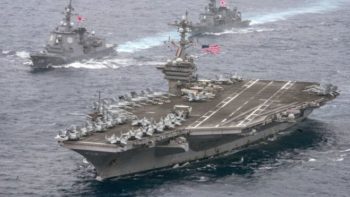
A United States aircraft carrier arrived in Vietnam on Monday for the first time since the end of the Vietnam War.
The arrival of the carrier dramatically underscores the growing strategic ties between the former foes at a time when China’s regional influence is rising.
The imposing grey silhouette of the USS Carl Vinson, could be seen from the cliff tops just outside the central Vietnamese city of Danang, where the 103,000-tonne carrier and two other U.S. ships begin a five-day visit.
“The visit marks an enormously significant milestone in our bilateral relations and demonstrates U.S. support for a strong, prosperous and independent Vietnam,”
“Through hard work, mutual respect, and by continuing to address the past while we work toward a better future, we have gone from former enemies to close partners,” the U.S. ambassador to Vietnam, Daniel Kritenbrink, said in a statement.
The arrival of the Vinson marks the biggest U.S. military presence in Vietnam since 1975 – but it also illustrates Hanoi’s complex and evolving relationship with Beijing over the disputed South China Sea as China announced its largest rise in defense spending in three years.
Vietnamese envoys had been working for months to ease the concerns of their giant Chinese neighbor over the visit and the prospect of broader security cooperation between Hanoi and Washington, according to diplomats and others familiar with the talks.
U.S. carriers frequently cross the South China Sea in a rising pattern of naval deployments, and are now routinely shadowed by Chinese naval vessels, naval officers in the region say.
“We’ve met with numerous international entities. We’ve seen several, so yes, we’ve seen Chinese ships,”
“We’ve seen other ships out there, so nothing extraordinary. It’s been a routine deployment and everything we’ve seen has been exceptionally professional,” Rear Admiral John Fuller, Commander, Carrier Strike Group 1, told reporters in Danang.
China’s rapid construction and build-up of the land it holds in the disputed Spratly islands group has alarmed Vietnam and other regional governments, as it seeks to enforce its claims to much of the disputed waterway, through which some $3 trillion in trade passes each year.
While some Chinese commentators have used the Vinson’s presence to demand an even greater Chinese military build-up in the South China Sea, official reaction from Beijing has been relatively muted since the stop was announced in January.
That announcement came during a two-day visit to Hanoi by U.S. Defense, Secretary James Mattis, and followed months of backroom military diplomacy between Hanoi and the Pentagon.
Although no U.S. aircraft carrier has been to Vietnam since the end of the war, other, smaller U.S. warships have made high-level visits.
Those include a 2016 visit by submarine tender USS Frank Cable and guided-missile destroyer USS John S. McCain to Cam Ranh Bay, a crucial logistics complex during the Vietnam War.
A U.S. Navy band will play a concert in Danang during the Vinson’s visit, and sailors from the carrier are to spend time at a treatment center for people who were exposed to Agent Orange chemicals during the war.
Agency Report